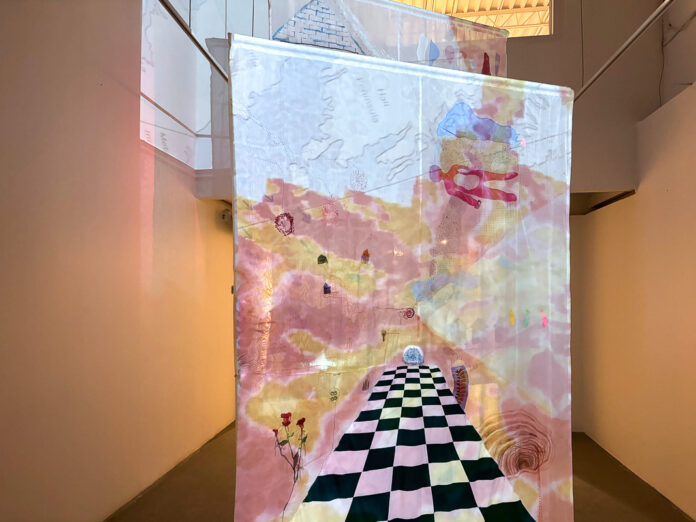
For Montreal-based artist Tania Lara, geographies are interwoven with human identity. To explore that intersection, Lara turned to embroidery.
“The threading speaks of an active gesture,” she said. “We’re always threading together different parts of our identity, different parts of our communities and different pieces of the environment that surrounds us.”
Lara’s embroidery exhibit Threading Topographic Tales, ran at Gallery 101 from Feb. 10 to March 16. The exhibit featured counter-cartographic textile maps, audio recordings and video projections to highlight themes of gender-based violence, identity, femininity and imaginings of a brighter future.
Counter-cartographic mapping is a growing practice of creating new maps that further social and political change to challenge existing systems of power.
“Conventional cartography is very bottom-up, where there is one specific truth imposed on ways of moving through the land,” Lara said. “Counter-cartography is wanting to acknowledge that there are infinite ways of living through space.”
The inspiration for Threading Topographic Tales came to Lara while she was studying at the Université du Québec à Montréal and writing her master’s degree thesis on autogeography as an artistic project and research method.
“It’s not a very common concept,” Lara said about the term “autogeography,” describing it as an intersection of identity, land and the body. For Lara, autogeography situates identity as something that is “always overflowing.”
“It’s a practice where you put together different pieces of land and territories that surround you—but that includes territories within you as well.”
Threading Topographic Tales featured three of Lara’s autogeographic embroidery maps.
Near the exhibit’s entrance, “autogeography #4” is a large-scale textile and video artwork created with the help of video technician Karina Arabelaez. The textile features details of Lara’s emotional and geographic life, including red flowers and a check-patterned pathway. Maps projected upon the textile symbolize Lara’s intertwining relationship between her identity and land.
“autogeography #2” and “autogeography #3” also explore Lara’s identity by incorporating inspiration from her recurring dreams and emotional landscapes.
“I always dream that I’m on the subway, climbing some stairs, or about the rain. I tried to put all of that into one kind of crazy map,” Lara said.
“Those are very personal,” she added. “It was always my goal to go deeper into my own stories and my own territories, but always with the objective of reaching outwards.”
Santiago Tavera, curator of Threading Topographic Tales, said he and Lara worked together to create an immersive narrative.
“We started by filling the space with Tania’s exploration of her questioning her own body and identity, then we were able to incorporate moving from the private to the public space,” Tavera said.
Textiles “casa en fuego” (Spanish for “house on fire”) and “pieles vivas” (Spanish for “living skins”) depicted patriarchal structures that target BIPOC and transgender bodies.
“I worked in Oaxaca, Mexico, where I photographed graffiti in the city that touched on gender violence,” Lara said of “pieles vivas.” “I embroidered those graffitis into a type of shawl called a rebozo.”
A long Mexican garment, Lara’s rebozo showed colourful graffiti-style spray painted and embroidered phrases such as “justicia” (Spanish for “justice”) and “me cuidan mis amigas no ta policia” (Spanish for “my friends take care of me, not the police”).
“For me, it was kind of a collaboration with anonymous works. That’s what graffiti is all about,” Lara said.
Kristina Corre, administrator of Gallery 101, said the show “builds” from intimate stories to shared understandings.
“The ground floor is more intimate, then upstairs you have communal works where you’re imagining new worlds together,” Corre said.
The second floor of Gallery 101 featured Lara’s collaborative projects.
“utopía,” two embroidered canvases with images such as human bodies and a compass, was a collaborative work by 15 women in Bogotá, Columbia. The piece also included a 20-minute audio recording of the artists’ conversations.
“We were trying to think about how we can make our cities better,” Lara said.
Lara added that some of the ideas the artists worked with included imagining parks, streets and hospitals named after women.
“That project was very centred on the thoughts of our craziest dreams,” Lara said. “To be able to create a different world, we have to start by imagining something different.”
The final piece in the exhibit, “tu’ux kumek’kuba’ob lemootsobo” (Yucatec Maya language for “Where the roots meet”), was created by 30 participants from Yaxcabá, a village in the Yucatán peninsula of Mexico.
A picture book displayed the participants’ embroidered work, accompanied by a video and audio clip of the group’s conversations in Spanish about their art.
“I was really interested in the collective part of art making, and how art can be an important factor for social change and community building,” Lara said.
Tavera said he thinks Threading Topographic Tales shows how geography, bodies and identities are not “fully static.”
“Our identities are parts of different intersectionalities that compose us,” he said. “Identities are multiple, everlasting and always in flux.”
Featured image by Kristina Corre.





